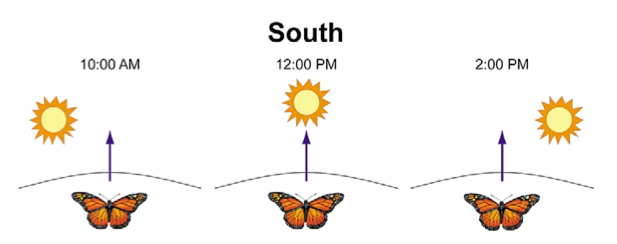The Sun Compass
To navigate across thousands of miles to a precise overwintering location, monarch butterflies need a map and a compass. The aspects of a map sense that are in place in migrants include which direction to fly (southwest) and where to stop (fir groves in central Mexico). More is known about the compass senses that migrants use to orient in the southerly direction over the course of their migration.
It is now felt that the primary compass sense that migrants rely on to orient south is the use of a sun compass. But it’s not as simple as just following the sun. As the earth rotates about its axis, the sun appears to move across the sky from horizon to horizon; the sun is thus a moving target, but the butterfly’s destination is a fixed point. To compensate for the sun’s predictable daily motion, monarchs use a circadian clock. Together, the orientation process that uses the sun compass and the circadian clock is more properly known as a time-compensated sun compass—a compass that adjusts itself over the hours.

Reppert, SM. Cold Spring Harb Symp Quant Biol. 2007;72:113-8
See Flight Simulator to learn how we know, by tracking flight behavior, that the butterflies use this mechanism.
Steering to the south is sufficient for the bulk of the migrating monarch’s travels. As millions of butterflies begin to approach Texas, they are funneled together by two barriers—the Gulf of Mexico on their left and the Rocky Mountains/Sierra Madre Mountains on the right. But once the butterflies continue to approach their destination, how do they find their way to the same grove in Michoacán, year after year? We postulate that there is a “destination beacon” that guides the butterflies to this forest. The nature of the destination beacon is not yet know but may involve olfactory cues given off at the overwintering site by the oyamel trees living in the unique pine forest in which the butterflies roost.
Prevailing winds out of the North, barometric pressure, and riding thermals also contribute to a successful migration south.